The Impact of the Urban Heat Island on the Sensation of Thermal Comfort and Electricity Consumption in Sfax in Central-Eastern Tunisia during the Hot Season
Abstract
Highlights
- The calculated HI, UTCI and THW indices show that thermal difference between the city center and the peri-urban area is greater in terms of perceived temperatures (thermal comfort indices) than in terms of air temperatures (UHI) at night in summer, especially during the heat wave period.
- A correlation between temperature distribution and electrical energy consumption was found. In fact, During the hot period, the overconsumption of electricity can reach 400% in the downtown area.
- The improvement of thermal comfort is possible by promoting natural ventilation.
- reducing the UHI would reduce the consumption of electrical energy in summer.
Abstract
1. Introduction
2. Study Area, Data and Methods
2.1. Study Area
2.2. Meteorological Data
2.3. Data on Electrical Energy Consumption
3. Results
3.1. Urban Heat Island in Sfax: Main Thermal Aspects in the Conurbation
3.2. Thermal Comfort Indices: Spatial and Temporal Variations According to Weather Type
3.2.1. Breezy Summer Weather
3.2.2. Very Hot Weather
3.3. Electrical Energy Consumption: The Role of Air Conditioning
4. Discussion
5. Conclusions
Author Contributions
Funding
Acknowledgments
Conflicts of Interest
Nomenclature
| CC | cloud cover octas |
| MRT | mean radiant temperature |
| XYZ | geographic coordinates |
| HI °C | heat index |
| RH % | relative humidity |
| T a °C | air temperature |
| T g °C | globe temperature |
| THW °C | temperature humidity wind index |
| Ts °C | surface temperature |
| UHI | urban heat index |
| UTCI °C | universal thermal climate index |
| V a m/s | wind speed |
Appendix A
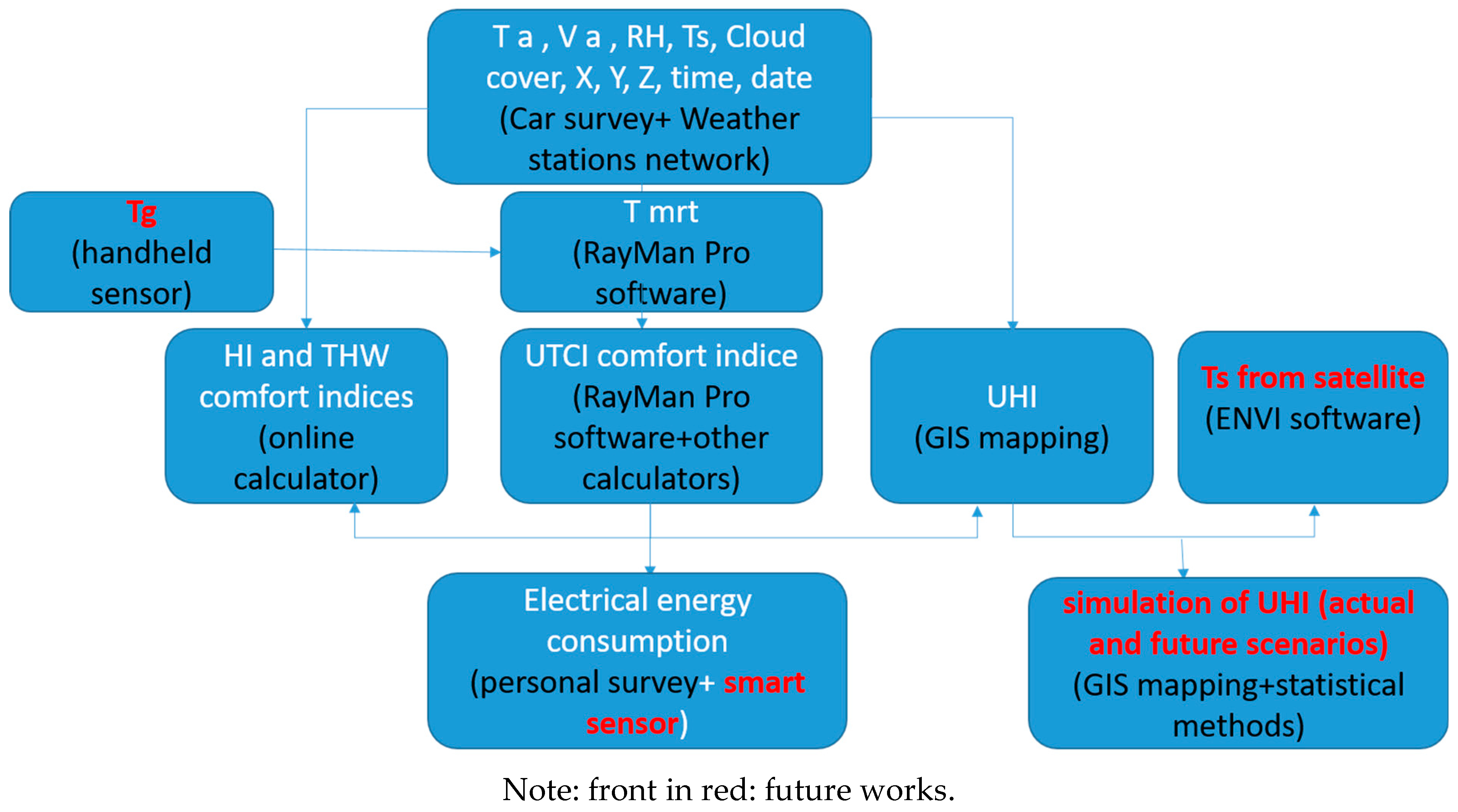
References
- Oke, T.R. City size and the urban heat island. Atmos. Environ. 1973, 7, 769–779. [Google Scholar] [CrossRef]
- Djen, C.S. The urban climate of Shanghai. Atmos. Environ. Part B Urban Atmos. 1992, 26, 9–15. [Google Scholar] [CrossRef]
- Kłysik, K.; Fortuniak, K. Temporal and spatial characteristics of the urban heat island of Łódź, Poland. Atmos. Environ. 1999, 33, 3885–3895. [Google Scholar] [CrossRef]
- Porson, A.; Harman, I.N.; Bohnenstengel, S.I.; Belcher, S.E. How Many Facets are Needed to Represent the Surface Energy Balance of an Urban Area? Bound.-Layer Meteorol. 2009, 132, 107–128. [Google Scholar] [CrossRef]
- Fujibe, F. Urban warming in Japanese cities and its relation to climate change monitoring. Int. J. Clim. 2011, 31, 162–173. [Google Scholar] [CrossRef]
- Santamouris, M. Analyzing the heat island magnitude and characteristics in one hundred Asian and Australian cities and regions. Sci. Total Environ. 2015, 512–513, 582–598. [Google Scholar] [CrossRef]
- Magli, S.; Lodi, C.; Contini, F.; Muscio, A.; Tartarini, P. Dynamic analysis of the heat released by tertiary buildings and the effects of urban heat island mitigation strategies. Energy Build. 2016, 114, 164–172. [Google Scholar] [CrossRef]
- Chapman, S.; Watson, J.E.M.; Salazar, A.; Thatcher, M.; McAlpine, C.A. The impact of urbanization and climate change on urban temperatures: A systematic review. Landsc. Ecol. 2017, 32, 1921–1935. [Google Scholar] [CrossRef]
- Xi, C.; Ren, C.; Wang, J.; Feng, Z.; Cao, S.-J. Impacts of urban-scale building height diversity on urban climates: A case study of Nanjing, China. Energy Build. 2021, 251, 111350. [Google Scholar] [CrossRef]
- Landsberg, H. The urban climate. Academic, New York Lee DO (1979) Contrasts in warming and cooling rates at an urban and a rural site. Weather 1981, 34, 60–66. [Google Scholar] [CrossRef]
- Charalampopoulos, I.; Tsiros, I.; Chronopoulou-Sereli, A.; Matzarakis, A. Analysis of thermal bioclimate in various urban configurations in Athens, Greece. Urban Ecosyst. 2012, 16, 217–233. [Google Scholar] [CrossRef]
- Santamouris, M. On the energy impact of urban heat island and global warming on buildings. Energy Build. 2014, 82, 100–113. [Google Scholar] [CrossRef]
- Sun, Y.; Augenbroe, G. Urban heat island effect on energy application studies of office buildings. Energy Build. 2014, 77, 171–179. [Google Scholar] [CrossRef]
- Radhi, H.; Sharples, S.; Assem, E. Impact of urban heat islands on the thermal comfort and cooling energy demand of artificial islands—A case study of AMWAJ Islands in Bahrain. Sustain. Cities Soc. 2015, 19, 310–318. [Google Scholar] [CrossRef]
- Skelhorn, C.P.; Levermore, G.; Lindley, S.J. Impacts on cooling energy consumption due to the UHI and vegetation changes in Manchester, UK. Energy Build. 2016, 122, 150–159. [Google Scholar] [CrossRef]
- Costanzo, V.; Evola, G.; Marletta, L. Energy savings in buildings or UHI mitigation? Comparison between green roofs and cool roofs. Energy Build. 2016, 114, 247–255. [Google Scholar] [CrossRef]
- Groppi, D.; de Santoli, L.; Cumo, F.; Garcia, D.A. A GIS-based model to assess buildings energy consumption and usable solar energy potential in urban areas. Sustain. Cities Soc. 2018, 40, 546–558. [Google Scholar] [CrossRef]
- Salvati, A.; Roura, H.C.; Cecere, C. Assessing the urban heat island and its energy impact on residential buildings in Mediterranean climate: Barcelona case study. Energy Build. 2017, 146, 38–54. [Google Scholar] [CrossRef]
- Boccalatte, A.; Fossa, M.; Gaillard, L.; Menezo, C. Microclimate and urban morphology effects on building energy demand in different European cities. Energy Build. 2020, 224, 110129. [Google Scholar] [CrossRef]
- Santamouris, M.; Haddad, S.; Saliari, M.; Vasilakopoulou, K.; Synnefa, A.; Paolini, R.; Ulpiani, G.; Garshasbi, S.; Fiorito, F. On the energy impact of urban heat island in Sydney: Climate and energy potential of mitigation technologies. Energy Build. 2018, 166, 154–164. [Google Scholar] [CrossRef]
- Ma, Y.X.; Yu, C. Impact of meteorological factors on high-rise office building energy consumption in Hong Kong: From a spatiotemporal perspective. Energy Build. 2020, 228, 110468. [Google Scholar] [CrossRef]
- Singh, M.; Sharston, R. Quantifying the dualistic nature of urban heat Island effect (UHI) on building energy consumption. Energy Build. 2021, 255, 111649. [Google Scholar] [CrossRef]
- Mayer, H.; Matzarakis, A.; Iziomon, M.G. Spatio-temporal variability of moisture conditions within the Urban Canopy Layer. Theor. Appl. Clim. 2003, 76, 165–179. [Google Scholar] [CrossRef]
- Holmer, B.; Thorsson, S.; Eliasson, I. Cooling rates, sky view factors and the development of intra-urban air temperature differences GeografiskaAnnaler: Series A. Phys. Geogr. 2007, 89, 237–248. [Google Scholar] [CrossRef]
- Heaviside, C.; Vardoulakis, S.; Cai, X.-M. Attribution of mortality to the urban heat island during heatwaves in the West Midlands, UK. Environ. Health 2016, 15, 49–59. [Google Scholar] [CrossRef]
- Tzoulas, K.; Korpela, K.; Venn, S.; Yli-Pelkonen, V.; Kaźmierczak, A.; Niemela, J.; James, P. Promoting ecosystem and human health in urban areas using Green Infrastructure: A literature review. Landsc. Urban Plan. 2007, 81, 167–178. [Google Scholar] [CrossRef]
- Liu, Y.; Stouffs, R.; Tablada, A.; Wong, N.H.; Zhang, J. Comparing micro-scale weather data to building energy consumption in Singapore. Energy Build. 2017, 152, 776–791. [Google Scholar] [CrossRef]
- Dahech, S.; Ghribi, M. Réchauffement climatique en ville et ses répercussions énergétiques. Cas de l’agglomération de Sfax (centre-est de la Tunisie). Méditerranée 2017, 128, 29–38. [Google Scholar] [CrossRef]
- Ghribi, M.; Euchi, H.; Dahech, S. Inconfort Thermique et Olfactif dans l’agglomération de Sfax: Perception dans les Quartiers Populaires de Sfax-Ouest (Tunisie). XXXIIème Colloque de l’Association Internationale de Climatologie, Thessaloniki-Grèce 29 mai au 1 Juin 2019; pp. 359–364. Available online: http://www.climato.be/aic/colloques/actes/Thessaloniki2019_actes.pdf (accessed on 5 December 2022).
- Li, X.; Zhou, Y.; Yu, S.; Jia, G.; Li, H.; Li, W. Urban heat island impacts on building energy consumption: A review of approaches and findings. Energy 2019, 174, 407–419. [Google Scholar] [CrossRef]
- IPCC. Climate Change 2021: The Physical Science Basis. Contribution of Working Group I to the Sixth Assessment Report of the Intergovernmental Panel on Climate Change; Masson-Delmotte, V., Zhai, P., Pirani, A., Connors, S., Péan, C., Berger, S., Caud, N., Chen, Y., Goldfarb, L., Gomis, M., et al., Eds.; Cambridge University Press: Cambridge, UK; New York, NY, USA, 2021; in press. [Google Scholar] [CrossRef]
- Johnson, D.P.; Wilson, J.S. The socio-spatial dynamics of extreme urban heat events: The case of heat-related deaths in Philadelphia. Appl. Geogr. 2009, 29, 419–434. [Google Scholar] [CrossRef]
- Arbuthnott, K.; Hajat, S.; Heaviside, C.; Vardoulakis, S. Changes in population susceptibility to heat and cold over time: Assessing adaptation to climate change. Environ. Health 2016, 15, 73–93. [Google Scholar] [CrossRef] [PubMed]
- Le Tertre, A.; Lefranc, A.; Eilstein, D.; Declercq, C.; Medina, S.; Blanchard, M.; Chardon, B.; Fabre, P.; Filleul, L.; Jusot, J.-F.; et al. Faculty Opinions recommendation of Impact of the 2003 heatwave on all-cause mortality in 9 French cities. Epidemiology 2006, 17, 75–79. [Google Scholar] [CrossRef] [PubMed]
- Andrade, H.; Alcoforado, M.-J. Microclimatic variation of thermal comfort in a district of Lisbon (Telheiras) at night. Theor. Appl. Climatol. 2008, 92, 225–237. [Google Scholar] [CrossRef]
- Deng, Z.; Deng, Q.; Wang, L.; Xiang, P.; Lin, J.; Murugadoss, V.; Song, G. Modifying coconut shell activated carbon for improved purification of benzene from volatile organic waste gas. Adv. Compos. Hybrid Mater. 2021, 4, 751–760. [Google Scholar] [CrossRef]
- Dahech, S. Le vent à Sfax (Tunisie), Impacts sur le Climat et la Pollution Atmosphérique. Ph.D. Thesis, de l’Université Paris: Paris, France, 2007; Volume VII, p. 309 + annexes. [Google Scholar]
- Dahech, S. Évolution de la répartition spatiale des températures de l’air et de surface dans l’agglomération de Sfax entre 1987 et 2010. Impact sur la consommation d’énergie en été. Climatologie 2012, 9, S11–S32. [Google Scholar] [CrossRef]
- Ghribi, M.; Dahech, S. Caractéristiques de l’îlot de chaleur urbain à Sfax durant la saison chaude (centre-est de la Tunisie). Climatologie 2020, 17, 7. [Google Scholar] [CrossRef]
- Steadman, R.G. The Assessment of Sultriness. Part II: Effects of Wind, Extra Radiation and Barometric Pressure on Apparent Temperature. J. Appl. Meteorol. 1979, 18, 874–885. [Google Scholar] [CrossRef]
- Jendritzky, G.; de Dear, R.; Havenith, G. UTCI—Why another thermal index? Int. J. Biometeorol. 2012, 56, 421–428. [Google Scholar] [CrossRef]
- Broede, P.; Fiala, D.; Blazejczyk, K.; Holmér, I.; Jendritzky, G.; Kampmann, B.; Tinz, B.; Havenith, G. Deriving the operational procedure for the Universal Thermal Climate Index (UTCI). Int. J. Biometeorol. 2011, 56, 481–494. [Google Scholar] [CrossRef]
- Bröde, P.; Krüger, E.L.; Rossi, F.A.; Fiala, D. Predicting urban outdoor thermal comfort by the Universal Thermal Climate Index UTCI—A case study in Southern Brazil. Int. J. Biometeorol. 2011, 56, 471–480. [Google Scholar] [CrossRef]
- Havenith, G.; Fiala, D.; Blazejczyk, K.; Richards, M.; Bröde, P.; Holmér, I.; Rintamaki, H.; Benshabat, Y.; Jendritzky, G. The UTCI-clothing model. Int. J. Biometeorol. 2011, 56, 461–470. [Google Scholar] [CrossRef] [PubMed]
- Fiala, D.; Havenith, G.; Bröde, P.; Kampmann, B.; Jendritzky, G. UTCI-Fiala multi-node model of human heat transfer and temperature regulation. Int. J. Biometeorol. 2011, 56, 429–441. [Google Scholar] [CrossRef] [PubMed]
- Park, S.; Tuller, S.E.; Jo, M. Application of Universal Thermal Climate Index (UTCI) for microclimatic analysis in urban thermal environments. Landsc. Urban Plan. 2014, 125, 146–155. [Google Scholar] [CrossRef]
- Pappenberger, F.; Jendritzky, G.; Staiger, H.; Dutra, E.; Di Giuseppe, F.; Richardson, D.; Cloke, H.L. Global forecasting of thermal health hazards: The skill of probabilistic predictions of the Universal Thermal Climate Index (UTCI). Int. J. Biometeorol. 2014, 59, 311–323. [Google Scholar] [CrossRef]
- Vatani, J.; Golbabaei, F.; Dehghan, S.F.; Yousefi, A. Applicability of Universal Thermal Climate Index (UTCI) in occupational heat stress assessment: A case study in brick industries. Ind. Health 2016, 54, 14–19. [Google Scholar] [CrossRef]
- Baaghideh, M.; Mayvaneh, F.; Shojaee, T. Evaluation of human thermal comfort using UTCI index: Case study Khorasan Razavi Iran. Nat. Environ. Chang. 2016, 2, 165–175. [Google Scholar]
- Fanger, P. Thermal Comfort; McGraw Hill: New York, NY, USA, 1972. [Google Scholar]
- Nikolopoulou, M.; Baker, N.; Steemers, K. Improvements to the globe thermometer for outdoor use. Archit. Sci. Rev. 1999, 42, 27–34. [Google Scholar] [CrossRef]
- Abreu-Harbich, L.V.; Labaki, L.; Matzarakis, A. Thermal bioclimate in idealized urban street canyons in Campinas, Brazil. Theor. Appl. Clim. 2013, 115, 333–340. [Google Scholar] [CrossRef]
- Ndetto, E.L.; Matzarakis, A. Urban atmospheric environment and human biometeorological studies in Dar es Salaam, Tanzania. Air Qual. Atmos. Health 2014, 8, 175–191. [Google Scholar] [CrossRef]
- Yang, S.-Q.; Matzarakis, A. Implementation of human thermal comfort information in Köppen-Geiger climate classification—The example of China. Int. J. Biometeorol. 2016, 60, 1801–1805. [Google Scholar] [CrossRef]
- Matzarakis, A.; Rutz, F.; Mayer, H. Modelling radiation fluxes in simple and complex environments—Application of the RayMan model. Int. J. Biometeorol. 2007, 51, 323–334. [Google Scholar] [CrossRef] [PubMed]
- Matzarakis, A.; De Rocco, M.; Najjar, G. Thermal bioclimate in Strasbourg—The 2003 heat wave. Theor. Appl. Clim. 2009, 98, 209–220. [Google Scholar] [CrossRef]
- Matzarakis, A.; Rutz, F.; Mayer, H. Modelling radiation fluxes in simple and complex environments: Basics of the RayMan model. Int. J. Biometeorol. 2010, 54, 131–139. [Google Scholar] [CrossRef] [PubMed]
- Matzarakis, A.; Fröhlich, D. Influence of urban green on human thermal bioclimate—application of thermal indices and micro-scale models. Acta Hortic. 2018, 1215, 1–9. [Google Scholar] [CrossRef]
- Matzarakis, A.; Gangwisch, M.; Fröhlich, D. RayMan and SkyHelios Model. In Urban Microclimate Modelling for Comfort and Energy Studies; Palme, M., Salvati, A., Eds.; Springer: Cham, Switzerland, 2021; pp. 339–361. [Google Scholar] [CrossRef]
- Fröhlich, D.; Gangwisch, M.; Matzarakis, A. Effect of radiation and wind on thermal comfort in urban environments—Application of the RayMan and SkyHelios model. Urban Clim. 2018, 27, 1–7. [Google Scholar] [CrossRef]
- Dahech, S. Impact de la brise de mer sur le confort thermique au Maghreb oriental durant la saison chaude. Cybergeo Eur. J. Geogr. 2014. [Google Scholar] [CrossRef]
- Charfi, S.; Dahech, S. Cartographie des températures à Tunis par modélisation statistique et télédétection. Mappemonde 2018, 123, 1–16. [Google Scholar] [CrossRef]
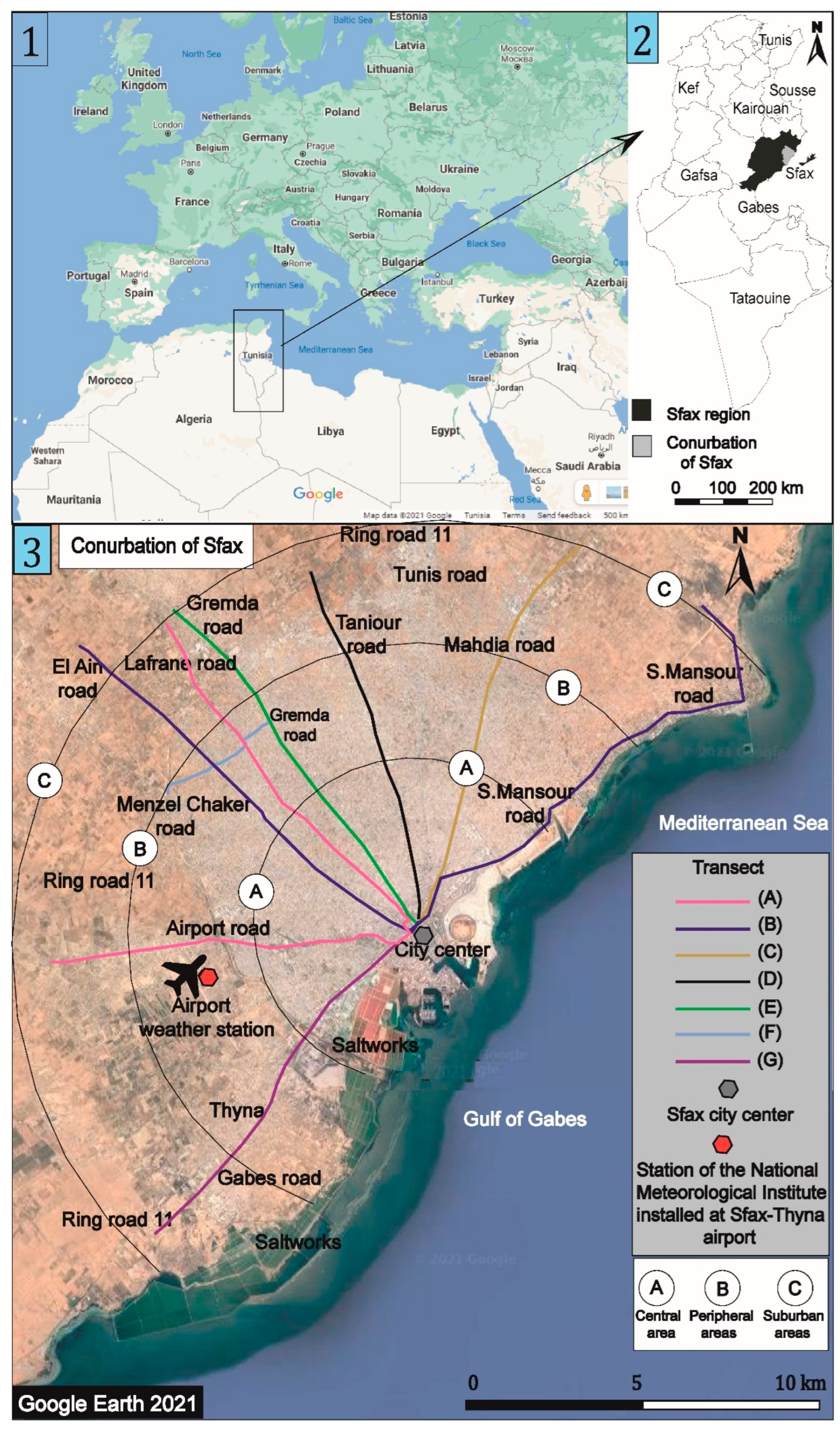
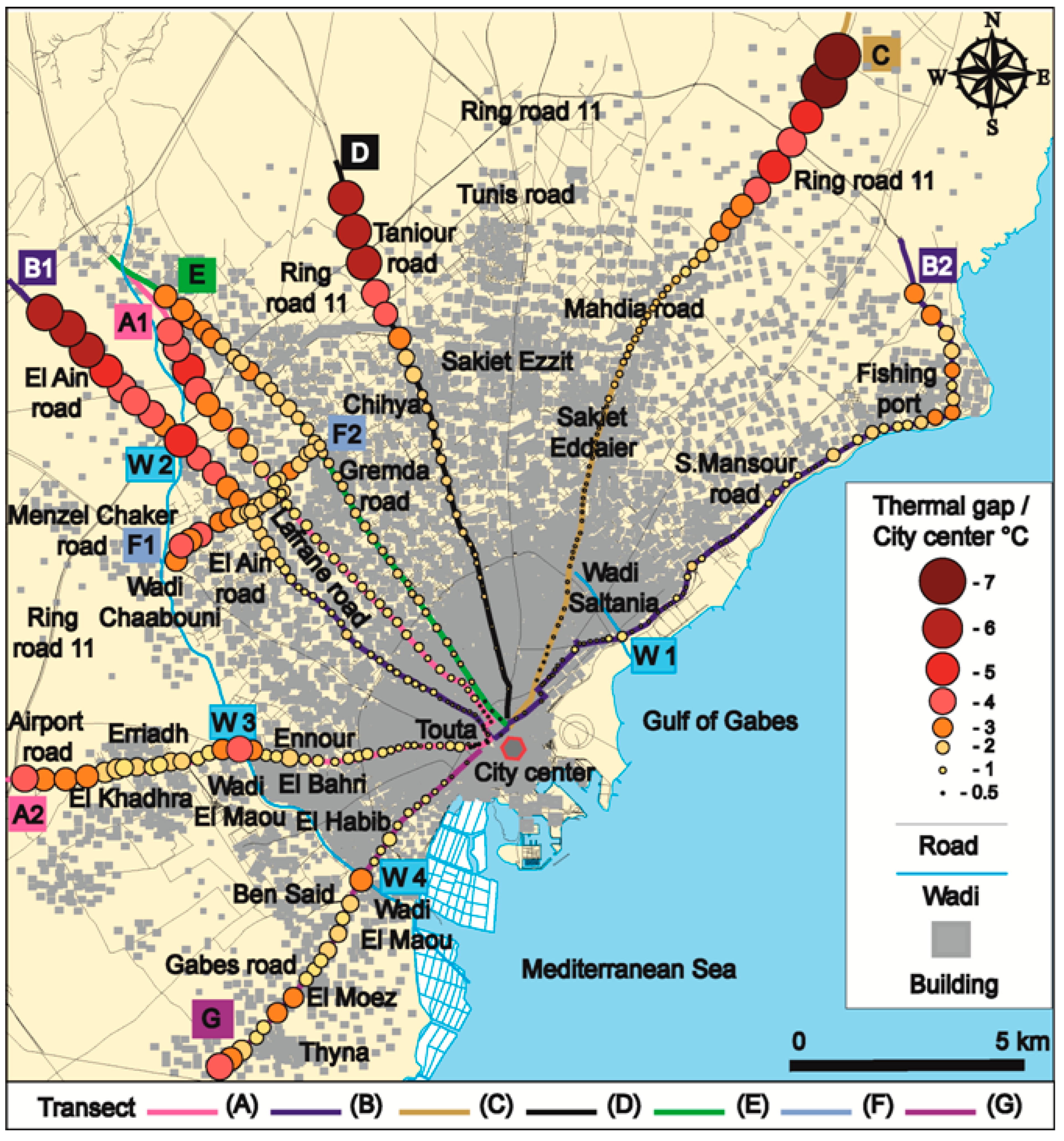
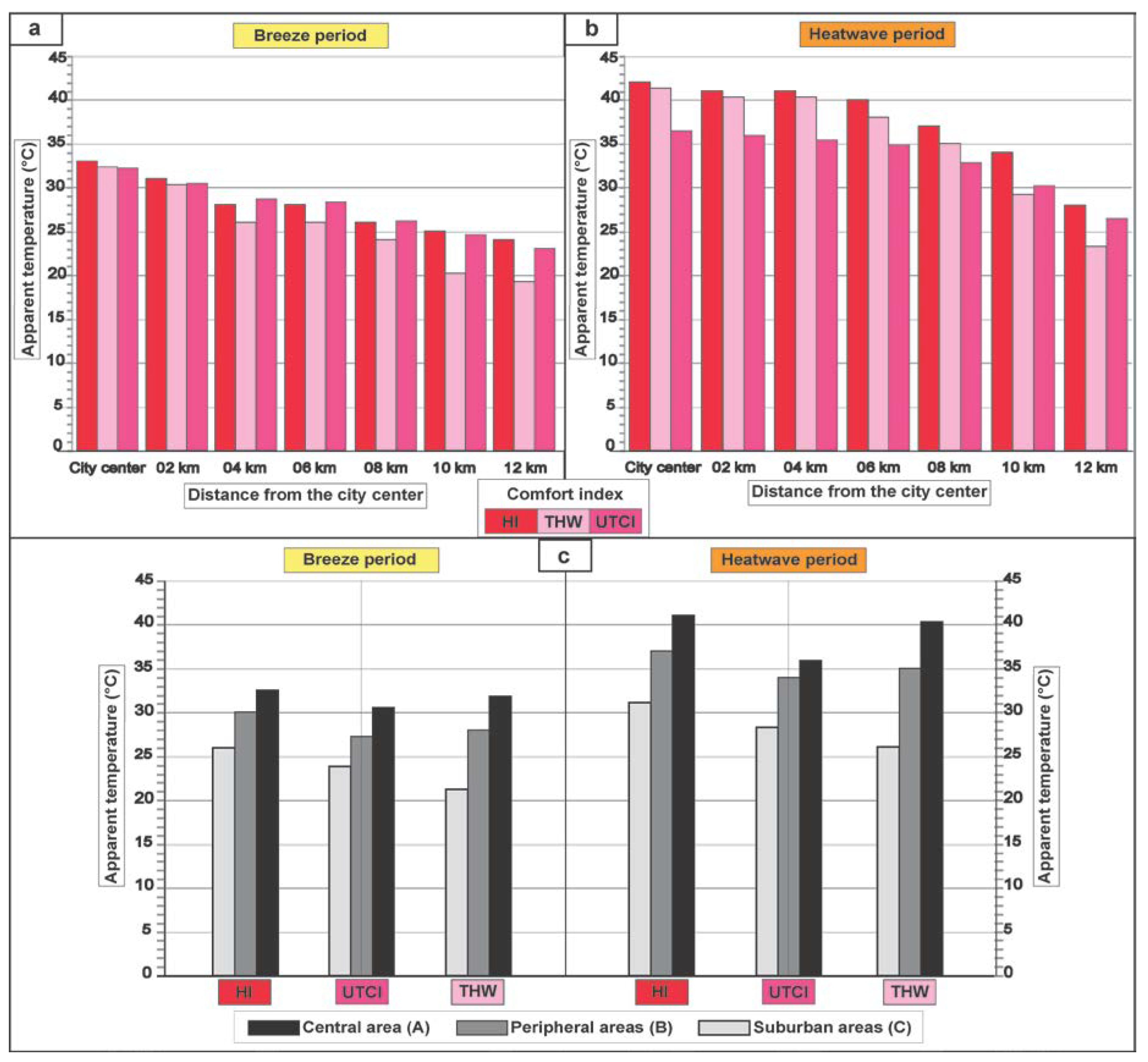
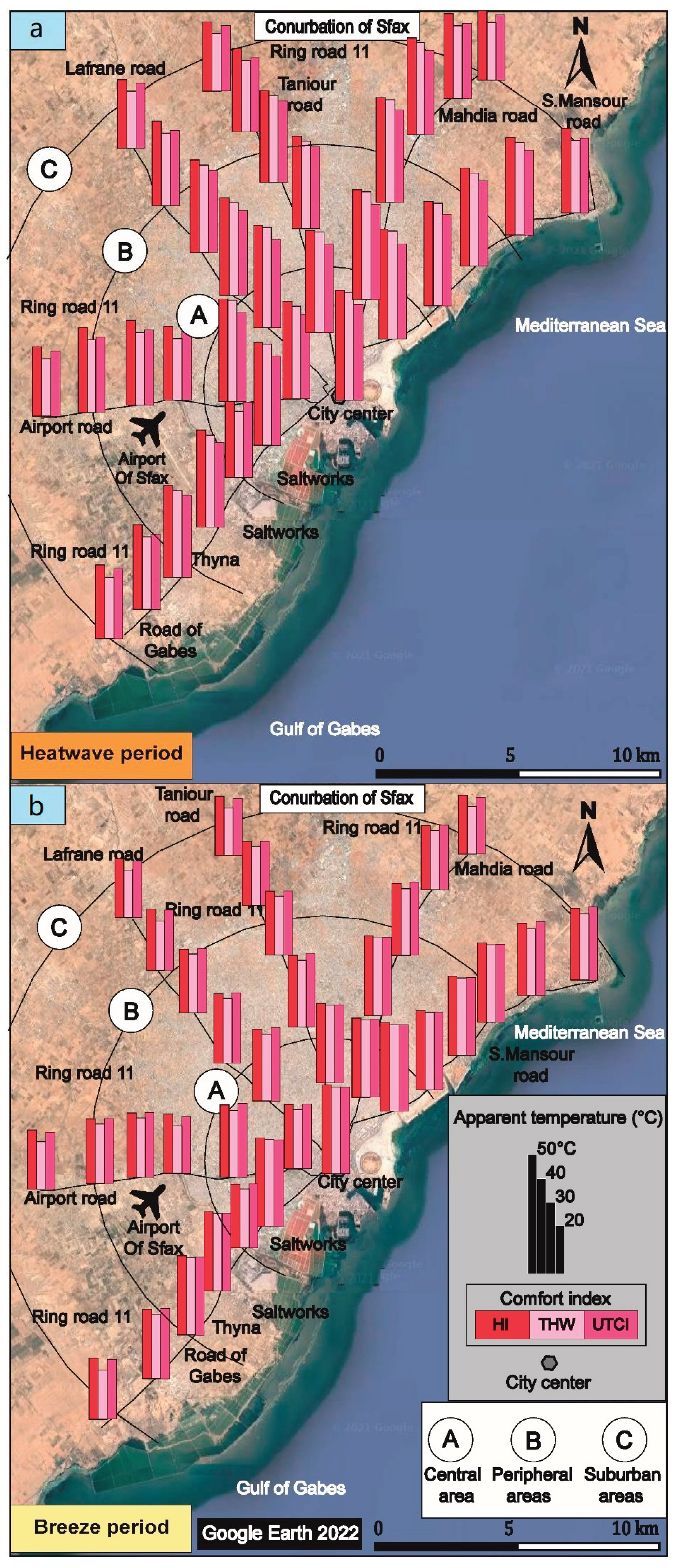
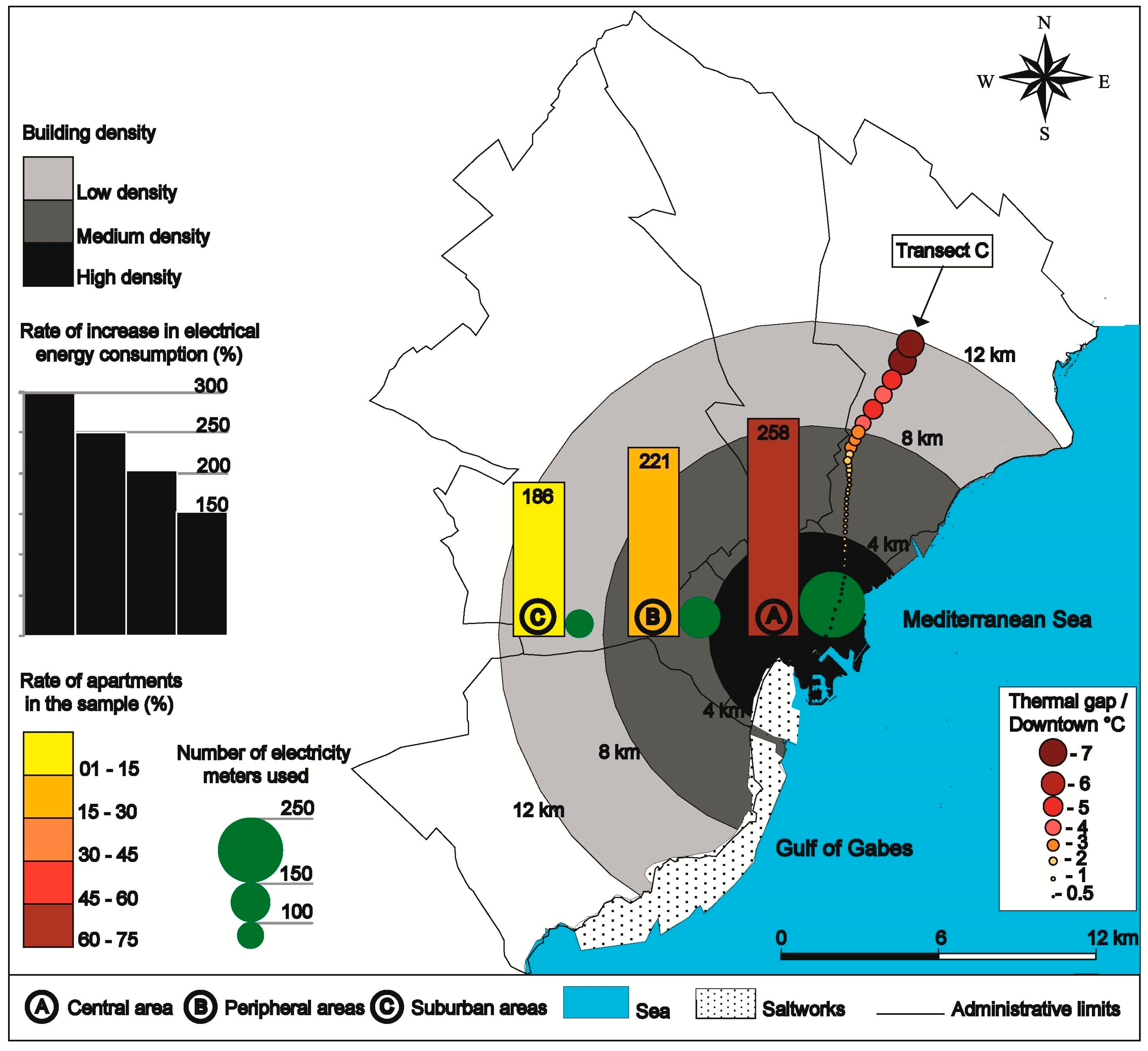
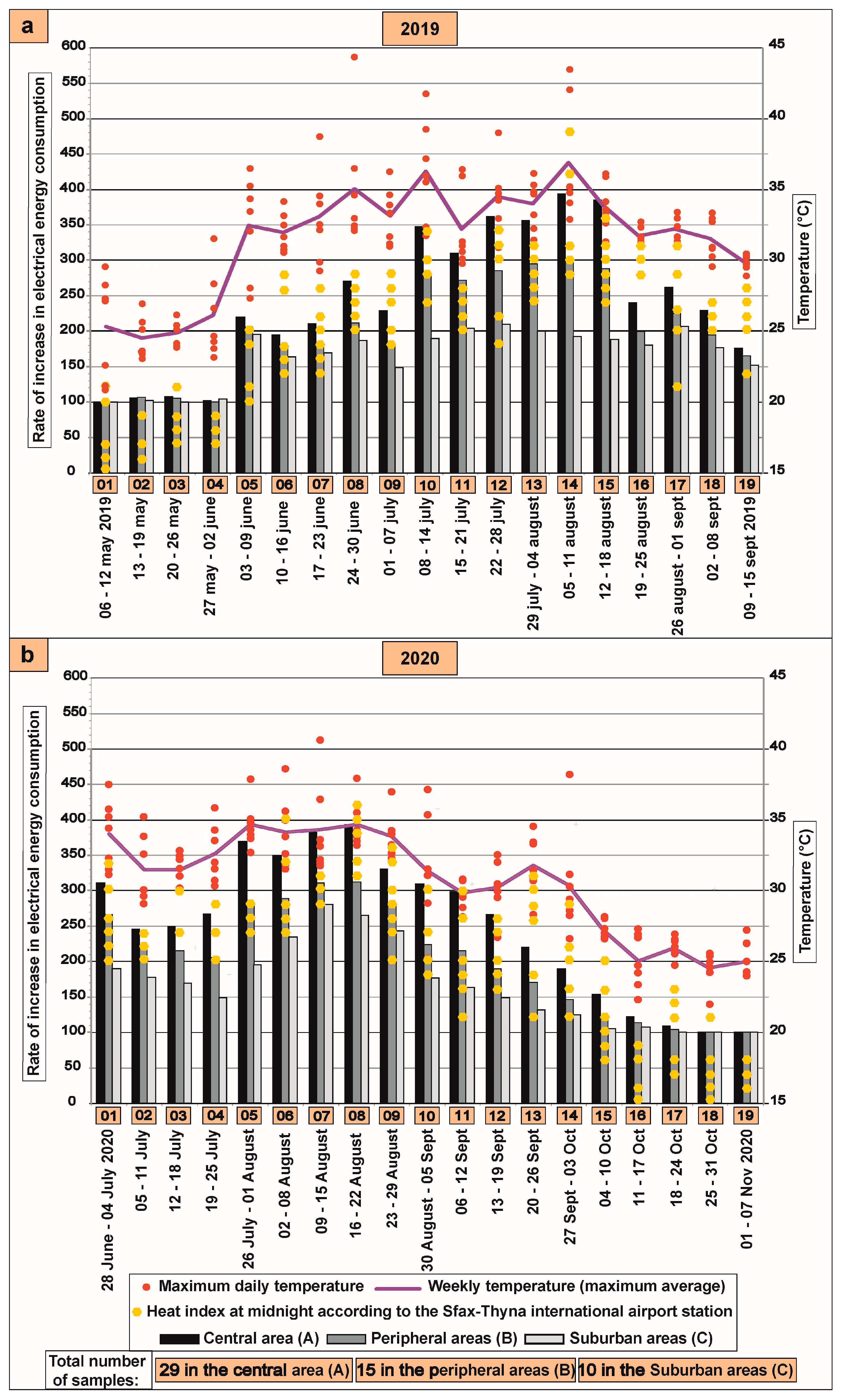
Disclaimer/Publisher’s Note: The statements, opinions and data contained in all publications are solely those of the individual author(s) and contributor(s) and not of MDPI and/or the editor(s). MDPI and/or the editor(s) disclaim responsibility for any injury to people or property resulting from any ideas, methods, instructions or products referred to in the content. |
© 2023 by the authors. Licensee MDPI, Basel, Switzerland. This article is an open access article distributed under the terms and conditions of the Creative Commons Attribution (CC BY) license (https://creativecommons.org/licenses/by/4.0/).
Share and Cite
Ghribi, M.; Dahech, S. The Impact of the Urban Heat Island on the Sensation of Thermal Comfort and Electricity Consumption in Sfax in Central-Eastern Tunisia during the Hot Season. Energies 2023, 16, 911. https://doi.org/10.3390/en16020911
Ghribi M, Dahech S. The Impact of the Urban Heat Island on the Sensation of Thermal Comfort and Electricity Consumption in Sfax in Central-Eastern Tunisia during the Hot Season. Energies. 2023; 16(2):911. https://doi.org/10.3390/en16020911
Chicago/Turabian StyleGhribi, Marwen, and Salem Dahech. 2023. "The Impact of the Urban Heat Island on the Sensation of Thermal Comfort and Electricity Consumption in Sfax in Central-Eastern Tunisia during the Hot Season" Energies 16, no. 2: 911. https://doi.org/10.3390/en16020911
APA StyleGhribi, M., & Dahech, S. (2023). The Impact of the Urban Heat Island on the Sensation of Thermal Comfort and Electricity Consumption in Sfax in Central-Eastern Tunisia during the Hot Season. Energies, 16(2), 911. https://doi.org/10.3390/en16020911






